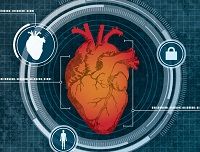Heartbeats will replace passwords
Our face, our voice, our fingers and our eyes are not the only elements that can be used to identify us with certainty. Researchers have created a biometric system that relies on digitizing a person's heart to determine its size, shape and rhythm. The goal ? Use this unique information as a biometric tool.

The demonstration was made by a team of researchers from the University of Buffalo, United States. The development of this system called Cardiac Scan took three years of work. Digitization detects the geometry, shape and size of a person's heart to identify it. "There are no two people with identical hearts," says Wenyao Xu, an assistant professor in the Computer Science and Engineering Department at the University of Buffalo. The shape of a heart does not change, except when people suffer from serious diseases, adds the researcher.

The digitization of the heart is done with a 2,4 GHz Doppler radar. The procedure takes only eight seconds, after which the identification is continuous. This means that as long as the person is using their computer or smartphone, the system recognizes it. Locking occurs automatically as soon as it moves away or someone else tries to connect.
This method has the advantage of being passive, contactless and totally transparent to the user who does not have to interact physically with a biometric reader or to remember passwords. Tested on 78 volunteers, the Cardiac Scan achieved a 98% success rate with people positioned one meter away from the Doppler radar. Currently, the device can track a person up to 30 meters away, which would allow, for example, to use it in airports. As for the waves emitted by the system, Professor Xu ensures that the signal strength is significantly lower than that of Wi-Fi and represents less than one percent of the radiation emitted by a smartphone.
The use of the heart as a biometric tool is not new. But so far, the work has focused on the signature of the heart rhythm, which has unique features.
We must have heard about cardiac identification, a biometric technology developed by a researcher at the Canadian University of Toronto that gave birth to the Nymi bracelet.

The Cardiac Scan presents itself as an even simpler solution for the user, who must simply stand in front of the Doppler radar for a few seconds. But it is still necessary that researchers manage to miniaturize their device to integrate it into a mobile terminal or a computer. This is probably the most difficult.
@cleverbot
What about your first name?
This post has received a 0.63 % upvote from @drotto thanks to: @banjo.
@originalworks
The @OriginalWorks bot has determined this post by @benedicta to be original material and upvoted(1.5%) it!
To call @OriginalWorks, simply reply to any post with @originalworks or !originalworks in your message!